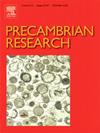华北克拉通景儿峪地层上部古地磁新成果及其构造地层学和古地理学意义
IF 3.2
2区 地球科学
Q2 GEOSCIENCES, MULTIDISCIPLINARY
引用次数: 0
摘要
本文章由计算机程序翻译,如有差异,请以英文原文为准。
New paleomagnetic results from the upper part of the Jingeryu Formation in the North China craton and their tectonostratigraphic and paleogeographic implications
The paleogeographic positions of the North China craton (NCC) during the late Mesoproterozoic to early Neoproterozoic are important to understand the supercontinent evolution. However, the published paleomagnetic results for this period were mainly obtained from the Liaodong–Xuhuai regions, situated along the eastern margin of the craton. They would further benefit from the data from more regions. In this study, we present the new paleomagnetic results obtained from the carbonate rocks of the upper part of the Jingeryu Formation (Fm) in the eastern Heibei Province, Yanliao basin, located in the interior of the NCC. Stepwise demagnetization revealed two distinct paleomagnetic remanence components. The low-stability component is likely a viscous magnetic remanence acquired in the recent geomagnetic field. Ninety-four samples retained a high-stability component, which is dual-polarity and characterized by notably steep inclinations, positioning the paleomagnetic pole at 45.6 °N, 139.6 °E (dp/dm = 8.7°/8.9°). The primary origin of the remanent magnetization is supported by positive fold and reversal tests, as well as the new pole’s distinctiveness from the younger NCC poles. The Jingeryu pole overlaps (at the 95 % confidence level) with poles from the lower part of the correlative strata, which are named Nanfen, Xinxing and Liulaobei formations in the Liaodong–Xuhuai regions at the eastern margin of NCC, but it differs significantly from other Precambrian NCC poles reported previously. We suggest that the upper part of the Jingeryu Fm correlates with the lower part of the Nanfen Fm and its equivalents. These results demonstrate that the previously identified late-Mesoproterozoic high-latitude (>∼70°) carbonate basin, primarily comprising the lower part of the Nanfen Fm and its equivalents situated along the eastern margin of the NCC, also includes the upper part of the Jingeryu Fm, which was deposited in a large area in the craton’s interior. Together with the updated global paleomagnetic database, our reconstruction indicates that the NCC was in high latitudes at ca. 1110 Ma, close to northwestern Laurentia and western Siberia, and separated by tens of degrees in latitude away from the low-latitude continental blocks including the Amazonian, Congo–São Francisco, Indian and Kalahari cratons.
求助全文
通过发布文献求助,成功后即可免费获取论文全文。
去求助
来源期刊

Precambrian Research
地学-地球科学综合
CiteScore
7.20
自引率
28.90%
发文量
325
审稿时长
12 months
期刊介绍:
Precambrian Research publishes studies on all aspects of the early stages of the composition, structure and evolution of the Earth and its planetary neighbours. With a focus on process-oriented and comparative studies, it covers, but is not restricted to, subjects such as:
(1) Chemical, biological, biochemical and cosmochemical evolution; the origin of life; the evolution of the oceans and atmosphere; the early fossil record; palaeobiology;
(2) Geochronology and isotope and elemental geochemistry;
(3) Precambrian mineral deposits;
(4) Geophysical aspects of the early Earth and Precambrian terrains;
(5) Nature, formation and evolution of the Precambrian lithosphere and mantle including magmatic, depositional, metamorphic and tectonic processes.
In addition, the editors particularly welcome integrated process-oriented studies that involve a combination of the above fields and comparative studies that demonstrate the effect of Precambrian evolution on Phanerozoic earth system processes.
Regional and localised studies of Precambrian phenomena are considered appropriate only when the detail and quality allow illustration of a wider process, or when significant gaps in basic knowledge of a particular area can be filled.
 求助内容:
求助内容: 应助结果提醒方式:
应助结果提醒方式:


